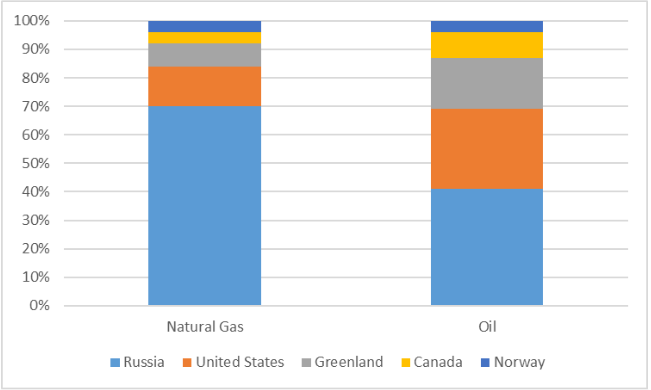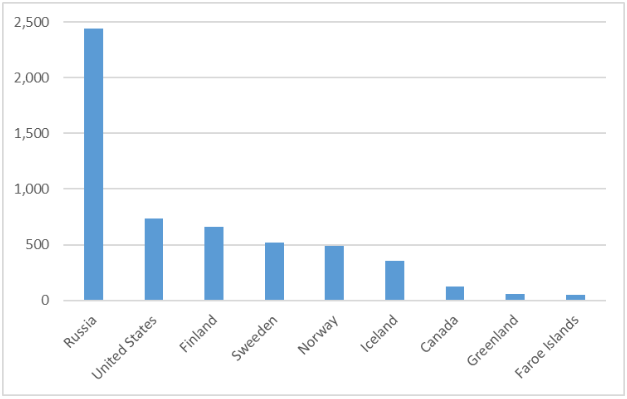The Great Game Heats Up in the Arctic
The US has several goals in the Arctic: Militarily, the United States wants to increase monitoring and deterrence of Russian naval and air activity in the region and into the North Atlantic. Economically, it is important that US companies profit from the development of mineral resources in Greenland and the Arctic. Strategically, to maintain global hegemony, it is vital that the US control the region and not allow any other great power to rise. All these ends can be achieved by negotiation. Furthermore, Greenland is not for sale and military action seems highly unlikely. Therefore, recent statements by the president-elect and his camp should be construed as posturing ahead of negotiations to secure US goals in Greenland.
Military Significance
Greenland is of immense military importance to the United States. For 75 years, its Thule Air Base has been key to detecting ICBMs launched against America and its allies early. As Russia continues to develop missile technology, particularly hypersonic missiles, including the rods-from-the-gods Oreshnik, against which reliable, effective defense currently does not exist, it would be prudent to improve and increase early launch detection and deploy countermeasures as they are developed. The importance of facilities in Greenland may increase further if US-China relations continue to deteriorate.
Air Force operations, including air defense and particularly reconnaissance, are likely to intensify in response to Russia’s increased military strength and capabilities. Greenland also offers a good vantage point for monitoring Russian Arctic naval activity, which is dominated by the Murmansk region, especially as traffic passing through the Greenland and Norwegian Seas into the North Atlantic is likely to increase.
Therefore, the United States is keenly interested in increasing its military presence in Greenland and the Arctic in general. Furthermore, this beefed-up US presence will force Russia to deploy more forces to counter. First, such redeployment of forces could potentially open in other theaters vulnerabilities that could be exploited by NATO. Second, more importantly, increased US presence would require Russia to devote more total resources to its military, placing additional strain on its economy. However, while the United States was more able to outlast the USSR technologically and economically under President Reagan’s Star Wars, it is not clear who is better situated today to win such a contest.
Deploying US missiles, conventional and nuclear, to Greenland would represent a very serious threat to Russia and provoke an equally serious response. Given that Russia’s advances in missile technology have yet to be equaled by the United States, it would seem more strategic to refrain from such provocative steps. The threat of, rather than actual deployment, may be more effective.
The Scramble for Arctic Resources
The Arctic, including Greenland, has great economic significance because it is one of the last vast areas of untapped resources. These minerals and energy are key to further global development and expansion. Whoever controls these resources will have an outsized influence on the advancement of our species.
In 2008, the US Geological Survey (USGS) published a comprehensive appraisal of oil gas reserves north of the Arctic Circle, indicating 90 billion barrels of oil (13% of the world’s total undiscovered oil), 50,000 bcm (billion cubic meters) of natural gas (30%) and 44 billion barrels of natural gas liquids. USGS estimated that the Arctic has 22% of the undiscovered energy resources, 84% of which are under the ocean floor. Actual reserves are likely to be higher due to advances in technology, identification of new deposits, and information on deposits that was not then available.
Figure 1: Russia Currently Dominates Arctic Hydrocarbon Reserves
Share of Arctic Oil and Natural Gas Reserves, %

Source: TsDU Fuel and Energy Ministry
Russia is leading in the race for these assets since it has the lion’s share of them with 35,700 bcm of natural gas and 19 billion barrels of oil. This is not surprising given that it has 53% of the coastline and some 2.5 million people live in Arctic Russia. Additionally, Russia has opened the Northern Sea Route, partially with the help of its nuclear-powered ice breaker fleet, which is the world’s only of its kind. This route to the Orient is shorter and thus less expensive.
Figure 2: Nearly Half of the People in the Arctic are Russian
Population of the Arctic by Country, thousands

Source: Andrei Smirnov, Russian Academy of Sciences
Greenland and the Arctic also have considerable mineral resources, including iron, copper, uranium and precious metals. Of particular interest are rare earth metals, which are extremely important for advanced electronics. If Western governments persist in forcing on the market inefficient, unreliable sources of energy, such as wind and solar panels, and wasting energy on electrifying processes such as heating and transportation, then demand for rare earths may skyrocket.
Rare earth minerals are not inherently rare, but economically viable concentrations of them are. The United States has 1.8 million tons of rare earth mineral reserves and was dominant in their production for decades until lower labor costs and NIMBY activists forced production to China, which now produces 60% of the total. Chinese market share of certain metals is considerably high, such as gallium, which is an astounding 98%. This gives China considerable economic leverage. Large swathes of US industry, including defense-related production, could be crippled. For this reason, the Arctic, including Greenland, which is very conservatively estimated to have 1.5 million tons of rare earth minerals (most of the island has not been thoroughly explored), is key to maintaining US economic and military superiority. (However, it should be noted that permitting in Greenland is stricter than in the United States, so the problem of where to build the processing plant/smelter, which is very dirty, remains.)
Furthermore, ensuring that American companies profit from the development of the Arctic will support the US economy.
More than One Way to Skin a Cat
As we have seen, the United States has military, strategic and commercial reasons to gain control of Greenland and increase its presence in the Arctic. How best to achieve this?
Denmark has repeatedly stated that Greenland is not for sale, and its inhabitants have expressed no desire to exchange one colonial power for another. Because only 56,000 people live there, it would not be difficult to astroturf a color revolution or manufacture consensus with economic incentives. However, the backlash in the Global South to such heavy-handed neocolonialism, especially on the heels of unilateral US action against Russia hurting the Global South, would seem too high a price to pay. It would also embolden other countries to undertake similar action.
Signing political, military and commercial agreements is far more effective and does so in a way unlikely to elicit much opposition. Indeed, this has been the approach of the US government, albeit cloaked in the language of “partnership” and “shared goals.” As the US ramps up pressure on NATO allies to contribute more to the alliance, Denmark’s ability to resist should be less. Imposing tariffs, or threatening to do so, would put more pressure on Denmark
If Greenland were to gain independence, achieving such agreement would be easier because it would have to replace the annual grant from Denmark of $550 million, representing some 20% of GDP and over half its budget.
Thus, recent statements are likely posturing. Trump considers himself the consummate businessman. The title of his book, “The Art of the Deal,” speaks volumes to his approach: Begin negotiations by setting out maximalist goals and “settle” for an agreement to achieve real goals instead of purchasing Greenland as the United States ostensibly wanted at the outset.
The United States won the Cold War but has not fared so well in the ensuing peace. As the war in Ukraine winds down, a better alternative to revolutions and military conflicts elsewhere would be competing with Russia, temporarily cooperating with China, for resources and strategic advantage in the Arctic, the new theater of the Great Game. An ideal alternative would involve cooperative efforts in the Arctic, or at least a return to détente, helping to ease tensions globally and set the stage for cooperation in the next phase of mankind’s great adventure—evolving into a spacefaring species.
The post The Great Game Heats Up in the Arctic appeared first on The Beacon.
Source: https://freedombunker.com/2025/01/16/the-great-game-heats-up-in-the-arctic/
Anyone can join.
Anyone can contribute.
Anyone can become informed about their world.
"United We Stand" Click Here To Create Your Personal Citizen Journalist Account Today, Be Sure To Invite Your Friends.
Before It’s News® is a community of individuals who report on what’s going on around them, from all around the world. Anyone can join. Anyone can contribute. Anyone can become informed about their world. "United We Stand" Click Here To Create Your Personal Citizen Journalist Account Today, Be Sure To Invite Your Friends.
LION'S MANE PRODUCT
Try Our Lion’s Mane WHOLE MIND Nootropic Blend 60 Capsules
Mushrooms are having a moment. One fabulous fungus in particular, lion’s mane, may help improve memory, depression and anxiety symptoms. They are also an excellent source of nutrients that show promise as a therapy for dementia, and other neurodegenerative diseases. If you’re living with anxiety or depression, you may be curious about all the therapy options out there — including the natural ones.Our Lion’s Mane WHOLE MIND Nootropic Blend has been formulated to utilize the potency of Lion’s mane but also include the benefits of four other Highly Beneficial Mushrooms. Synergistically, they work together to Build your health through improving cognitive function and immunity regardless of your age. Our Nootropic not only improves your Cognitive Function and Activates your Immune System, but it benefits growth of Essential Gut Flora, further enhancing your Vitality.
Our Formula includes: Lion’s Mane Mushrooms which Increase Brain Power through nerve growth, lessen anxiety, reduce depression, and improve concentration. Its an excellent adaptogen, promotes sleep and improves immunity. Shiitake Mushrooms which Fight cancer cells and infectious disease, boost the immune system, promotes brain function, and serves as a source of B vitamins. Maitake Mushrooms which regulate blood sugar levels of diabetics, reduce hypertension and boosts the immune system. Reishi Mushrooms which Fight inflammation, liver disease, fatigue, tumor growth and cancer. They Improve skin disorders and soothes digestive problems, stomach ulcers and leaky gut syndrome. Chaga Mushrooms which have anti-aging effects, boost immune function, improve stamina and athletic performance, even act as a natural aphrodisiac, fighting diabetes and improving liver function. Try Our Lion’s Mane WHOLE MIND Nootropic Blend 60 Capsules Today. Be 100% Satisfied or Receive a Full Money Back Guarantee. Order Yours Today by Following This Link.






